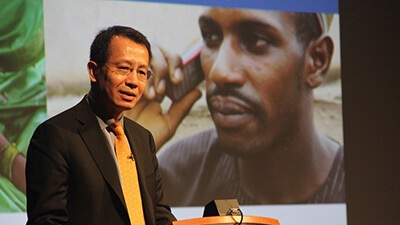Digital solutions and new technologies offer great potential to overcome massive development challenges and will contribute toward the World Bank Group achieving the goal of universal access to financial services by 2020, according to several speakers at a seminar at the 2014 Spring Meetings.
With 2.5 billion people in developing countries deprived of access to formal financial services and more than 200 million small businesses lacking access to the financing they need to grow, expanding access to finance remains a challenge.
“The benefits of digital finance extend well beyond conventional financial services: This can also be a powerful tool and an engine for job creation in developing countries,” said Jin-Yong Cai, International Finance Corporation executive vice president, and CEO, as he opened the forum, co-sponsored by IFC, World Bank, and the Consultative Group to Assist the Poor (CGAP).
The forum, moderated by CGAP director and CEO Tilman Ehrbeck, showcased companies that are implementing innovations in digital finance and was followed by a panel of private sector leaders and government representatives who discussed how these innovations can be taken to scale in developing countries.
Innovators from such firms as bKash, Airtel Money-Africa, and Mobisol described how their businesses are tackling major development challenges by deploying various approaches to digital finance.
“As millions of poor people use mobile money, like bKash, the poor contribute directly to generating many multiplier effects of the value which can be used in productive activities like funding businesses. This way digital money allows common people to contribute to the nation-building efforts and in the macroeconomics of the nation,” said Kamal Quadir, CEO of bKash.
Delivering financial services through technological innovations, including via mobile money, can be a catalyst for the provision and use of a diverse set of other financial services – including credit, insurance, savings, and financial education. Those who are now excluded can enjoy expanded access to money-transfer services, microloans, and insurance.
“The buzzword ‘digital finance’ is already an everyday reality for our Tanzanian, Kenyan, and Rwandan customers who are using Mobisol Solar Home Systems,” said Thomas Duveau, who leads business development for Mobisol. “Paying for solar power in small installments through mobile money is not a ‘fancy option’: It’s already the norm for commercial transactions by those at the bottom of the economic pyramid.”
Digital finance also has an important role to play for small businesses. It not only provides them with access to financing but also to electronic payment systems, secure financial products, and a chance to build a financial history. Arjuna Costa, the partner of Omidyar Network, underscored the importance of digital finance in terms of building the credit history and transactional data of individuals and firms for lenders.
Sandhya Rani, postmaster general of the Andhra Pradesh state in India, emphasized the huge potential of digital finance on rural development and the role the India Post has played. “With over 155,000 post offices, most of which are in rural areas, we are poised to play a critical role in enhancing financial inclusion, as we are able to effectively deliver a variety of financial services, including banking, insurance, and remittances even in the most remote areas of the country,” she said.
Walt Macnee, president of the MasterCard Center for Inclusive Growth, pointed out that innovations in electronic payment technology like mobile and prepaid enable people to live more secure, empowered, and included lives and that digital money will be the only way to achieve universal access to finance by the year 2020.
Concluding the session, panelists all agreed that for this type of innovation to be taken to scale, close public-private cooperation is a key factor in removing such barriers as cost, distance, and regulatory complexities.





